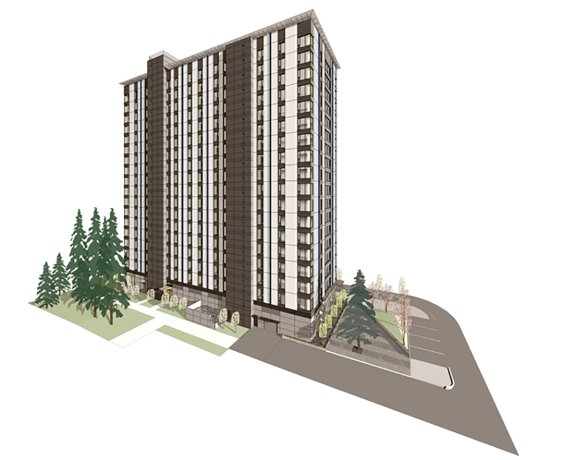While Ontario’s building code approved construction of wood-frame midrises up to six storeys as of January 2015, designers are already out the gate with taller structures in Canada.
Leading the way is an 18-storey students’ residence at the University of British Columbia (UBC) in Vancouver which just started construction, while excavation for a 13-storey mixed-use wood highrise in Quebec City called the Origine is expected to commence next spring, Mohammad Mohammad said recently at the Wood Solutions Fair conference in Toronto.
Both towers will put Canada on the global map of tall wood buildings. Currently, a 14-storey wood residence in Bergen, Norway holds the title as the tallest in the world.
Mohammad, a research leader at FPInnovations and a senior research advisor at Natural Resources Canada (NRCan), says tall wood buildings are viable largely because of a new generation of mass timber engineered wood products. Examples include cross-laminated timber (CLT), laminated strand lumber (LSL) and laminated veneer lumber (LVL).
Key design distinctions between midrise six-storey wood buildings and taller wood towers is that the latter must meet more stringent fire and structural requirements — achievable with mass timber, says Mohammad, who was at the conference representing FPInnovations, Canada’s national research organization on forest products.
Although wood midrises are limited to six storeys under "prescriptive provisions" in the Ontario building code, taller buildings can be approved under "alternative solutions," if designers demonstrate that they meet or exceed the performance requirements of non-combustible steel or concrete highrises, he says.
But demonstrating those performance requirements can take time and can be expensive. To offset testing costs, NRCan, in partnership with private industry and provinces, will partially fund research and development efforts by designers.
"It will help make their wood designs competitive with concrete or steel," says Mohammad.
Both the 18-storey UBC building and the 13-storey Quebec City tower received funding through an NRCan program called the Tall Wood Buildings Demonstration Initiative. The towers were selected through an expression of interest process led by the Canadian Wood Council, says Mohammad.
One of the reasons developers might turn to wood over concrete and steel for tall building projects is that wood is a sustainable and renewable building material, he says.
Speed of assembly (one to three storeys erected per week depending on the size of the building) and lighter weight on foundations are other benefits of wood which result in cost savings, adds Mohammad.
Further rationale for turning to wood might be esthetics. "Wood is warm. People like to work and live in a wood environment."
But for the tall wood buildings to "truly takeoff" in Canada, the research scientist says they need to be adopted in building codes.
Could that happen in the next four years?
"That is our hope," he says, noting that the Quebec government is leading the way with a set of guidelines for "pre-approved alternative solutions for mass timber up to 12-storeys."
"If you follow the design requirements specified in the Quebec Guide, than your building can be approved in Quebec," he says.
For now, Norway’s TREET still stands as the tallest tower in the world. It was built with a combination of a mass timber structural system and prefabricated light wood frame. Four-storey modules were built offsite and shipped to the property for erection, according to the project architect Marina Trifkovic, of ARTEC, who gave a seminar at the Wood Solutions Fair on the building.
Mohammad says the first "modern tall wood building (over six storeys)" designed and constructed in North America is the Wood Innovation and Design Centre (WIDC) on the campus of the University of Northern B.C. in Prince George. It is just under 30 metres tall.
"It is equivalent to an eight-storey residential building," says Mohammad, adding that the U.S. is also in the race to the sky, with several tall wood buildings in the works in Oregon, New York and Minneapolis.











Recent Comments
comments for this post are closed